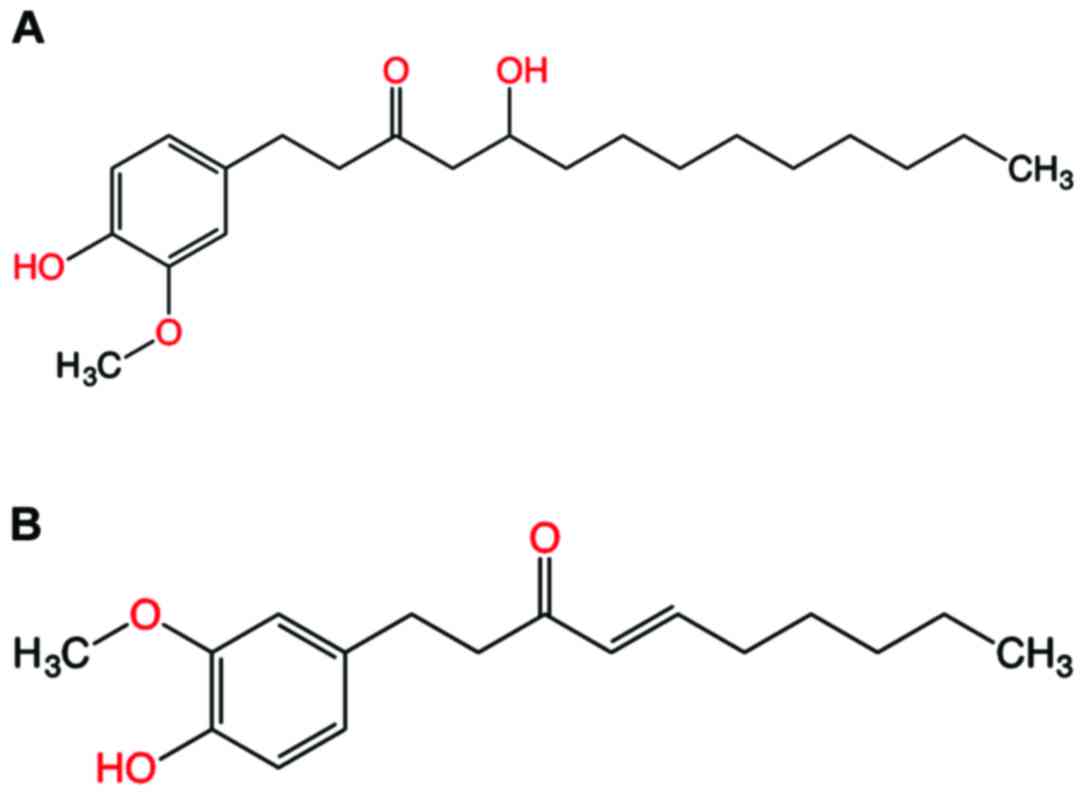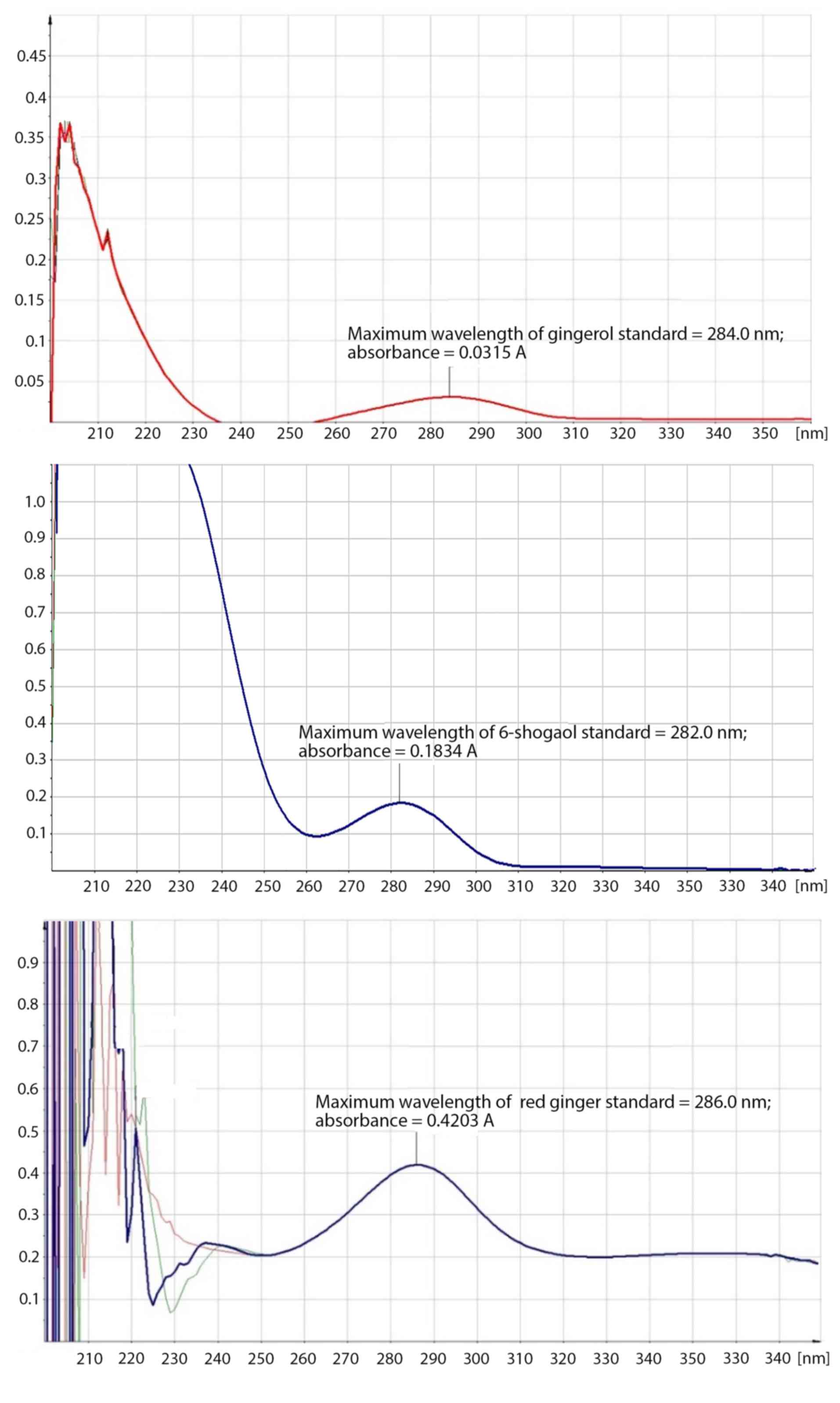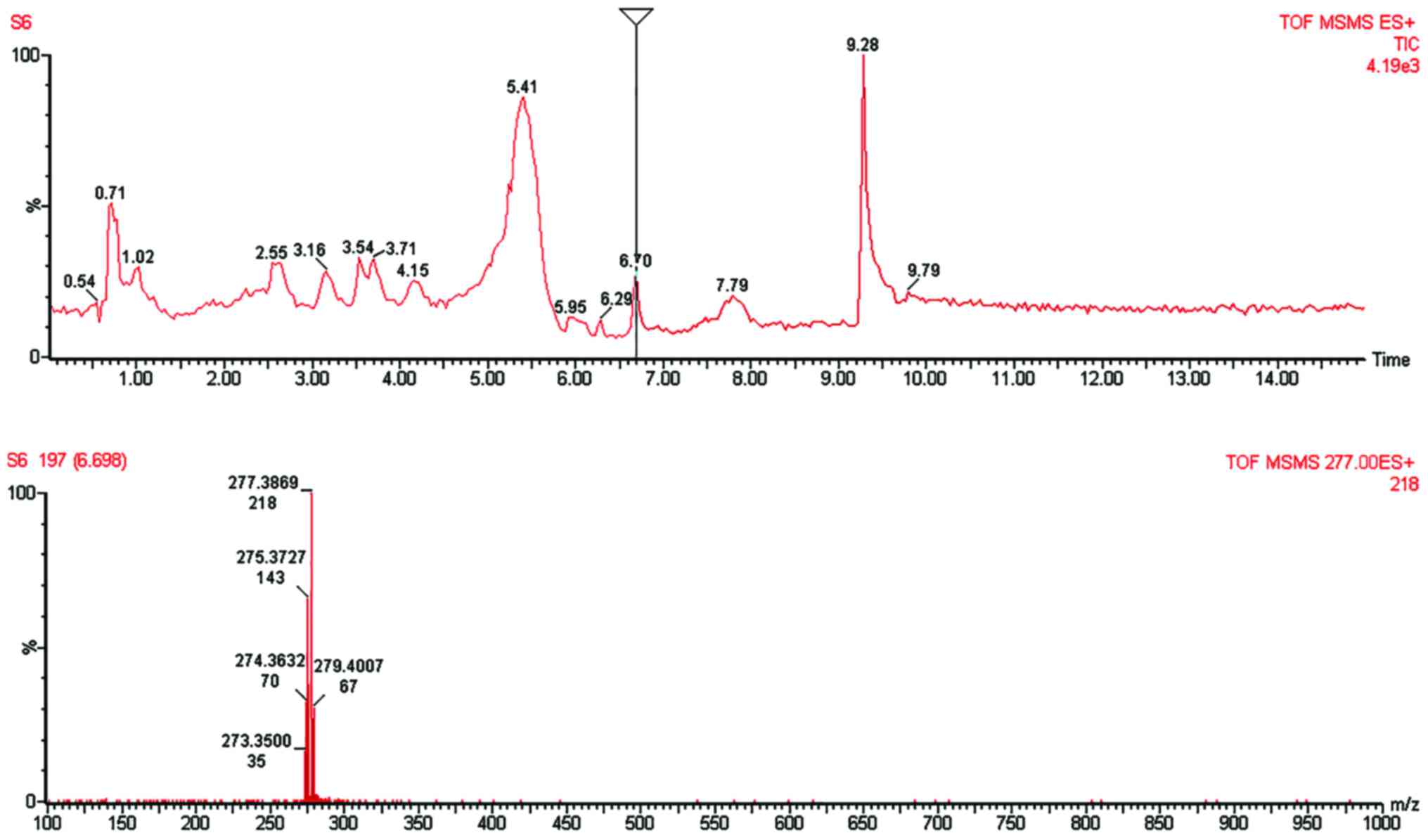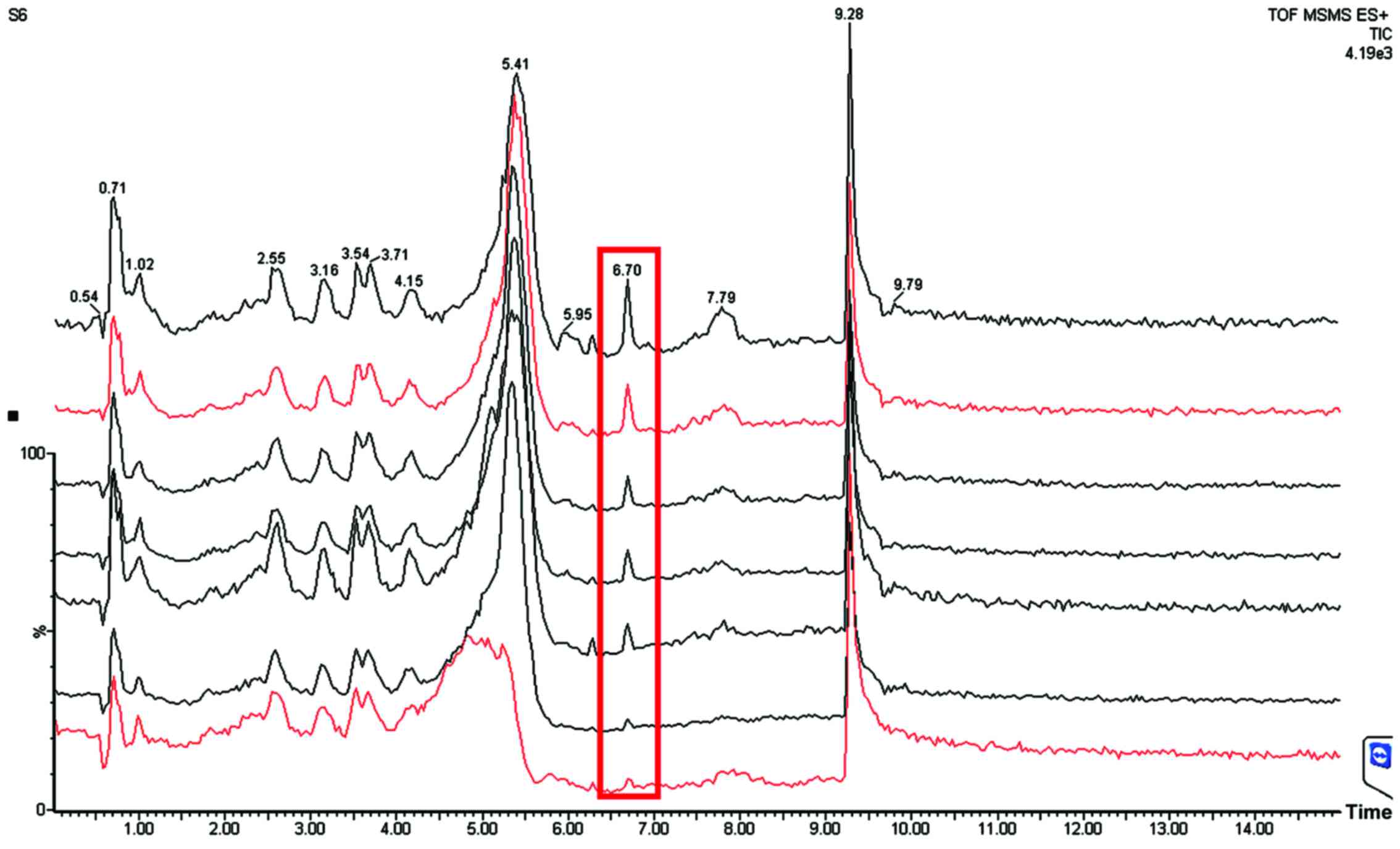|
1
|
Zhang X, Iwaoka WT, Huang AS, Nakamoto ST
and Wong R: Gingerol decreases after processing and storage of
ginger. J Food Sci. 59:1338–1340. 1994. View Article : Google Scholar
|
|
2
|
Hiserodt RD, Franzblau SG and Rosen RT:
Isolation of 6-, 8-, and 10-gingerol from ginger rhizome by HPLC
and preliminary evaluation of inhibition of Mycobacterium
avium and Mycobacterium tuberculosis. J Agric Food Chem.
46:2504–2508. 1998. View Article : Google Scholar
|
|
3
|
Young HY, Chiang CT, Huang YL, Pan FP and
Chen GL: Analytical and stability studies of ginger preparations.
Yao Wu Shi Pin Fen Xi. 10:149–153. 2002.
|
|
4
|
Riaz H, Begum A, Raza SA, Khan ZMUD,
Yousaf H and Tariq A: Antimicrobial property and phytochemical
study of ginger found in local area of Punjab, Pakistan. Int Curr
Pharm J. 4:405–409. 2015. View Article : Google Scholar
|
|
5
|
Ugwoke CEC and Nzekwe U: Phytochemistry
and proximate composition of ginger (Zingiber officinale). J
Pharm Allied Sci. 7:No. 5. 2010.
|
|
6
|
Bhargava S, Dhabhai K, Amla Batra A,
Sharma A and Malhotra B: Zingiber officinaleChemical and
phytochemical screening and evaluation of its antimicrobial
activities. J Chem Pharm Res. 4:360–364. 2012.
|
|
7
|
Prasad S and Tyagi AK: Ginger and its
constituents: Role in prevention and treatment of gastrointestinal
cancer. Gastroenterol Res Pract. 2015:1429792015. View Article : Google Scholar : PubMed/NCBI
|
|
8
|
Marrelli M, Menichini F and Conforti F: A
comparative study of Zingiber officinale Roscoe pulp and
peel: Phytochemical composition and evaluation of antitumour
activity. Nat Prod Res. 29:2045–2049. 2015. View Article : Google Scholar : PubMed/NCBI
|
|
9
|
Mashhadi NS, Ghiasvand R, Askari G, Hariri
M, Darvishi L and Mofid MR: Anti-oxidative and anti-inflammatory
effects of ginger in health and physical activity: Review of
current evidence. Int J Prev Med. 4 Suppl 1:S36–S42.
2013.PubMed/NCBI
|
|
10
|
Dhanik J, Arya N and Nand V: A review on
Zingiber officinale. J Pharmacogn Phytochem. 6:174–184.
2017.
|
|
11
|
Jiang H, Sólyom AM, Timmermann BN and Gang
DR: Characterization of gingerol-related compounds in ginger
rhizome (Zingiber officinale Rosc.) by high-performance
liquid chromatography/electrospray ionization mass spectrometry.
Rapid Commun Mass Spectrom. 19:2957–2964. 2005. View Article : Google Scholar : PubMed/NCBI
|
|
12
|
Tjendraputra E, Tran VH, Liu-Brennan D,
Roufogalis BD and Duke CC: Effect of ginger constituents and
synthetic analogues on cyclooxygenase-2 enzyme in intact cells.
Bioorg Chem. 29:156–163. 2001. View Article : Google Scholar : PubMed/NCBI
|
|
13
|
Afzal M, Al-Hadidi D, Menon M, Pesek J and
Dhami MSI: Ginger: An ethnomedical, chemical and pharmacological
review. Drug Metab Drug Interact. 18:159–190. 2001. View Article : Google Scholar
|
|
14
|
Grzanna R, Phan P, Polotsky A, Lindmark L
and Frondoza CG: Ginger extract inhibits beta-amyloid
peptide-induced cytokine and chemokine expression in cultured THP-1
monocytes. J Altern Complement Med. 10:1009–1013. 2004. View Article : Google Scholar : PubMed/NCBI
|
|
15
|
Lantz RC, Chen GJ, Sarihan M, Sólyom AM,
Jolad SD and Timmermann BN: The effect of extracts from ginger
rhizome on inflammatory mediator production. Phytomedicine.
14:123–128. 2007. View Article : Google Scholar : PubMed/NCBI
|
|
16
|
Ghasemzadeh A, Jaafar HZ and Rahmat A:
Variation of the phytochemical constituents and antioxidant
activities of Zingiber officinale var. Rubrum Theilade
associated with different drying methods and polyphenol oxidase
activity. Molecules. 21:7802016. View Article : Google Scholar
|
|
17
|
Dugasani S, Pichika MR, Nadarajah VD,
Balijepalli MK, Tandra S and Korlakunta JN: Comparative antioxidant
and anti-inflammatory effects of [6]-gingerol, [8]-gingerol,
[10]-gingerol and [6]-shogaol. J Ethnopharmacol. 127:515–520. 2010.
View Article : Google Scholar : PubMed/NCBI
|
|
18
|
Ippoushi K, Azuma K, Ito H, Horie H and
Higashio H: [6]-Gingerol inhibits nitric oxide synthesis in
activated J774.1 mouse macrophages and prevents
peroxynitrite-induced oxidation and nitration reactions. Life Sci.
73:3427–3437. 2003. View Article : Google Scholar : PubMed/NCBI
|
|
19
|
Kim SO, Kundu JK, Shin YK, Park JH, Cho
MH, Kim TY and Surh YJ: [6]-Gingerol inhibits COX-2 expression by
blocking the activation of p38 MAP kinase and NF-kappaB in phorbol
ester-stimulated mouse skin. Oncogene. 24:2558–2567. 2005.
View Article : Google Scholar : PubMed/NCBI
|
|
20
|
Fikri F, Saptarini NM, Levita J, Nawawi A,
Mutalib A and Ibrahim S: The inhibitory activity on the rate of
prostaglandin production by Zingiber officinale var. Rubrum.
Pharmacol Clin Pharm Res. 1:33–40. 2016.
|
|
21
|
Saptarini NM, Sitorus EY and Levita J:
Structure-based in silico study of 6-gingerol, 6-ghogaol, and
6-paradol, active compounds of ginger (Zingiber officinale)
as COX-2 inhibitors. Int J Chem. 5:12–18. 2013. View Article : Google Scholar
|
|
22
|
Zick SM, Djuric Z, Ruffin MT, Litzinger
AJ, Normolle DP, Alrawi S, Feng MR and Brenner DE: Pharmacokinetics
of 6-gingerol, 8-gingerol, 10-gingerol, and 6-shogaol and conjugate
metabolites in healthy human subjects. Cancer Epidemiol Biomarkers
Prev. 17:1930–1936. 2008. View Article : Google Scholar : PubMed/NCBI
|
|
23
|
Yu Y, Zick S, Li X, Zou P, Wright B and
Sun D: Examination of the pharmacokinetics of active ingredients of
ginger in humans. AAPS J. 13:417–426. 2011. View Article : Google Scholar : PubMed/NCBI
|
|
24
|
Zick SM, Ruffin MT, Djuric Z, Normolle D
and Brenner DE: Quantitation of 6-, 8-, and 10-gingerols and
6-shogaol in human plasma by high-performance liquid chromatography
with electrochemical detection. Int J Biomed Sci. 6:233–240.
2010.PubMed/NCBI
|
|
25
|
Şengül Ü: Comparing determination methods
of detection and quantification limits for aflatoxin analysis in
hazelnut. Yao Wu Shi Pin Fen Xi. 24:56–62. 2016.
|
|
26
|
Wohlmuth H: Phytochemistry and
pharmacology of plants from the ginger family, Zingiberaceae
(unpublished PhD thesis). Southern Cross University; Lismore, New
South Wales: 2008
|
|
27
|
Ghasemzadeh A, Jaafar HZ and Rahmat A:
Optimization protocol for the extraction of 6-gingerol and
6-shogaol from Zingiber officinalevar. rubrum
Theilade and improving antioxidant and anticancer activity using
response surface methodology. BMC Complement Altern Med.
15:2582015. View Article : Google Scholar : PubMed/NCBI
|
|
28
|
Chrubasik S, Pittler MH and Roufogalis BD:
Zingiberis rhizoma: A comprehensive review on the ginger effect and
efficacy profiles. Phytomedicine. 12:684–701. 2005. View Article : Google Scholar : PubMed/NCBI
|















